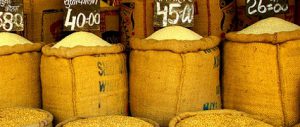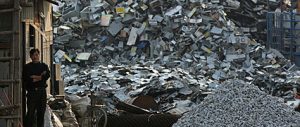In January 2006, in the southern Chinese village of Xinma, some 2,000 kilometres away from Side, two people died and a further 150 were diagnosed with chronic cadmium poisoning as a result of severe pollution. On September 11 that year, an investigation by the provincial government – Hunan province – found that the village’s groundwater and drinking water were unaffected, but that farmland had been polluted with cadmium and levels of heavy metals in local rice were well over safe limits.
In January 2011, a visit to Xinma, near Zhuzhou city, revealed that 1,000 mu (0.7 square kilometres) of land here and in two neighbouring villages had been declared unsuitable for crop planting. The villagers believe the main cause of the poisoning is a local motorcycle-parts factory that used to release cadmium-polluted water into the ground – as well as the cadmium pollution in the rice grown here.
To date, the local government still hasn’t published the quantities of cadmium found in the rice. However, in April 2008, a study group from Nanjing Agricultural University’s Institute of Resources, Ecosystem and Environment of Agriculture, headed up by Pan Genxing, obtained two samples of rice from villagers and found respective cadmium levels of 0.52 and 0.53 milligrams per kilogram – 2.5 times the legal limit.
The cadmium in Xinma’s fields comes mainly from the Xiang River, which lies one kilometre away and has the worst heavy-metal pollution of all of China’s rivers. One of the major sources of heavy metals in the Xiang is the Xiawan Industrial Zone, located several kilometres upstream from Xinma.
Dozens of square kilometres of farmland around Zhuzhou’s industrial zones have been affected by heavy-metal pollution. Villagers from Xinqiao, on the edge of the Xiawan zone, said that thousands of mu (a mu is 667 square metres) in the villages of Xinqiao, Xiawan and Jianshe were polluted by heavy-metal laden waste-water discharged from the zone before the 1980s. The local government has been handing out compensation of 400 kilograms of rice per mu for 20 years.
The Xiang River is used to irrigate huge areas of land as it passes through Zhuzhou and Xiangtan. While it is highly probable that land here has been polluted by heavy metals, research and data is lacking. Wang Guoxiang, deputy chair of the Xiangtan Environmental Protection Association, once paid out of his own pocket for soil and rice from the village of Yantang to be tested for contaminants: both were found to contain far too much cadmium.
After obtaining samples from Xinma, Pan Genxing’s team visited several other areas in south China reportedly suffering from cadmium pollution, including Dabaoshan in Guangdong, Bailutang in Hunan and Dayupiaotang in Jiangxi. Rice from all these locations was found to be badly contaminated, with cadmium levels of between 0.4 and 1 milligram per kilogram – two to five times the permitted level.
In the year 2000, researcher Liu Zhanqi and others from the China Institute for Radiation Protection carried out medical examinations on 260 people from a lead and zinc-mining area who had been exposed to cadmium for more than 20 years. Eighty-four of them were found to have lower bone density than normal, and most complained of strange pains. Of the 22 who had suffered the worst exposure, 19 had various degrees of bone weakness or softening.
In one zinc and lead mining area in the south of China, preliminary research also points to a link between high rates of cancer and cancer deaths and high levels of cadmium in the soil and rice.
Other heavy metals are also damaging China’s fields and rice. Feng Xinbin and colleagues at the Chinese Academy of Sciences’ Institute of Geochemistry published a paper on a number of mercury-polluted areas in Guizhou, south China, in the US journal Environmental Health Perspectives. They found that the main source of methylmercury – the cause of Minamata disease – for residents of inland China is rice rather than fish.
Meanwhile, in his 2009 doctoral thesis, Zhang Junhui of east China’s Zhejiang University found that, of nine villages near Taizhou city with a history of handling electronic waste, seven had fields that were polluted to some degree by cadmium, copper or zinc compounds. In 2008, Li Yonghua of the Chinese Academy of Science’s Institute of Geographic Sciences and Natural Resources Research and his team found rice in the lead and zinc mining areas of western Hunan to be tainted with high levels of lead and arsenic.
In the face of such extensive pollution, many people just give up, believing there is nothing to be done. In Xinma’s neighbouring village of Xinqiao, the villagers all know the rice is “poisoned” – but they have still been eating it for years. One villager expressed her helplessness: “People with money can avoid the bad rice, but the rest of us just have to live with it.”
Pan Genxing said that, in the west, large-scale farmers and agricultural companies will mostly abandon land polluted by heavy metals, or change the crops they plant on it. However, China’s poor farmers have no choice but to live with the pollution.
Academics point out that many western nations pay more attention to the environmental externalities of corporate behaviour than China, often using specific taxes to deal with issues such as soil pollution. The Chinese government lacks a system such as this; rather, the system actually encourages the creation of environmental externalities.
To compound matters, the government’s habitual secrecy over soil pollution has created a serious information imbalance between officials and the public – many small-hold farmers are unknowingly eating rice contaminated with heavy metals.
Eating habits also make the issue of contaminated rice more apparent in China. For 65% of China’s population, rice is the staple food. Academics calculate that, even if rice meets the national limit on cadmium content of 0.2 milligrams per kilogram, total cadmium intake for those in the south of China would still far exceed World Health Organization recommended limits.
With no supervision, or at least no effective supervision, contaminated rice enjoys a terrifying amount of “freedom”. Apart from in a few extreme cases, where the pollution is so severe that planting has been banned, the poor farmers who own most of the heavy-metal contaminated land are allowed to plant whatever crops they want, including rice. The villagers of Side and Xinqiao have received no orders from government to stop farming their land.
In fact, there are absolutely no restrictions on contaminated rice. The government has not banned the sale of rice grown in Side or Xinma and, while most is eaten by the villagers themselves, significant quantities are sold on.
Increased food-safety monitoring means that rice tainted with heavy metals is unlikely to have reached large supermarkets in major cities in recent years. But in the agricultural markets of county seats and small towns, nothing is being done.
In February 2008, food-safety checks in Chengdu found high cadmium levels in rice sold by the Qionglai Ruitai Rice Company and Sichuan Wenjun Rice Company, and demanded that both companies rectify the situation. Existing food-safety laws mean that their sale of contaminated rice was illegal, and sanctions would have been entirely justified.
And yet the companies themselves acted aggrieved. First, they explained, they simply buy whatever rice is available and, with intermediaries purchasing supplies from a complex range of sources, they are unable to tell where the rice comes from – and so cannot do anything to avoid purchasing contaminated rice. Second, they argued, the contamination in this instance had nothing to do with their processing systems – it was caused by cadmium in the soil.
A common view among academics is that the government has not banned the cultivation of rice on contaminated land, but has banned contaminated rice circulating on the market – a contradictory approach that is difficult to enforce.
The general belief is that little contaminated rice reaches China’s cities and that, as the source of rice for average city dwellers is constantly shifting, even if they do happen to eat some contaminated rice, the health risks are low.
But long-term observations made by Chen Tongbin, researcher at the Chinese Academy of Science’s Institute of Geographic Sciences and Natural Resources Research, and his colleagues indicate that, as farmers in affected areas get richer and learn more about health issues, they are more inclined to sell their contaminated rice off to the cities and buy in safe rice to eat themselves. In other words, the risk to urban residents is actually increasing.
In 2006, Wang Guoxiang, vice-chair of the Xiangtan Environmental Protection Association took urine samples from 500 residents living near Zhuzhou city and drinking water from the Xiang River. The samples were analysed by a medical institution in Changsha, with shocking results: 30% contained excessive levels of cadmium. Of these, 10% had high enough levels to require specialist treatment under state standards for prevention of occupational disease.
Various restrictions prevented Wang from carrying out further studies, but some researchers have said they believe cadmium-contaminated rice, as well as the river water, may have contributed to the result, as contaminated rice has been found on the market in Xiangtan.
Whether or not China’s officials and public are ready to face up to the problem of heavy-metal contamination in the food supply, the research points to a trend that requires urgent attention. In the future, it looks set to replace pesticides as the major source of China’s food scares.
This article first appeared in Century Weekly, where Gong Jing is a reporter.
Part one: How serious is cadmium pollution?
Homepage image from Greenpeace


